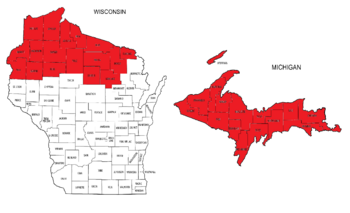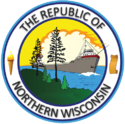Superior
This article is incomplete because it is pending further input from participants, or it is a work-in-progress by one author. Please comment on this article's talk page to share your input, comments and questions. Note: To contribute to this article, you may need to seek help from the author(s) of this page. |
Republic of Northern Wisconsin | |
|---|---|
|
Flag | |
| Motto: Our right, our land! | |
 | |
| Capital | Iron Mountain |
| Largest city | Superior |
| Official languages | English |
| Demonym(s) | Wisconsinite |
| Government | Provisional Presidential Republic |
• Provisional President | William Kinnard |
• Provisional Deputy-President | Edwin Mills |
| Legislature | Provisional State Council |
| Independence from Great Lakes Federation | |
| Area | |
• Total | 35,841 sq mi (92,830 km2) |
| Population | |
• 2020 estimate estimate | 661,807 |
• Density | 18.4/sq mi (7.1/km2) |
| Currency | Northern Wisconsin Dollar |
| Time zone | CST |
| Date format | dd-mm-yyyy |
| Driving side | right |
| Internet TLD | .nw |
Northern Wisconsin officially the Republic of Northern Wisconsin is a self-proclaimed breakaway state in the midwest region of North America. It lies between the Republic of the Heartland and the Great Lakes Federation and Lake Superior, occupying an area of 92,830 km2 (35,841 sq mi), with a population of about 661,000. Northern Wisconsin declared its independence from the Great Lakes Federation two years after the shattering and has since gained diplomatic recognition as a sovereign state from The Republic of the Heartlands. Most of Northern Wisconsin is covered in a mixture of plains and fields and dense forests. Its capital is Iron Mountain and largest city is Superior.
History
The Shattering
Following a disputed election, and a tie vote, the U.S. Congress installs the most unpopular President in U.S. history, as David Jefferson Adams becomes the 44th President of the United States. Shortly after the election, increased unrest, rioting, and a growing number of militias have given rise to ever-increasing domestic terrorism. In response, the President invokes the Homeland Security Act, and declares martial law on the West Coast, and other areas of the country. Though highly contested, a Supreme Court ruling sidesteps the electoral process, disqualifying popular Presidential candidates from several states. Public outrage explodes when a sham election leads to incumbent David Adams accepting a second term in office. During the 57th Inauguration Day ceremonies, Washington, D.C. is struck by a low-yield nuclear weapon, killing David Adams and most of the U.S. Congress. The destruction of Washington, D.C. effectively breaks the chain of succession, sending the nation into chaos. In an emergency vote, NATO deploys peacekeepers to the greater D.C. area, to secure international interests. With separatist sentiment rising, California's governor declares home rule, and secedes from the Union. Texas follows quickly, and declares sovereignty, taking neighboring states with them and forming the Republic of Texas. Following suit, other separatist movements gave rise to Cascadia, the Republic of the Heartland, Great Lakes Federation, Georgia Federation and New England.
Early Movements
The idea of the republic originated from a little known man named William Arthur Kinnard. During the early months of the existence of the Great Lakes Federation (GLF), Kinnard and a small group of locals were upset about the policies and government of the GLF. Kinnard believed the government to be corrupt, the people of northern wisconsin and the upper peninsula under-represented, and that the policies and motives of the GLF did not align with that of the people in northern Wisconsin. GLF policies became increasingly authoritarian, and made local governments extremely reliant on the federation government in Columbus, Ohio. Local decision making near impossible without the stamp of approval from Columbus. To make matters worse, the federation government appointed loyal GLF supporters to local government roles to insure the cooperation of individual states and counties. Amidst growing tensions between the successor states, the Great Lakes Federation was experiencing trouble maintaining control and implimenting its policies in fringe areas, such as northern Wisconsin, southern Illinois and parts of western New York. Locals became increasingly rebellious and refused to abide by mandates made in Columbus.
Militant Separatists
Basing himself in Iron County, Wisconsin, Kennard began the preparation and planning of armed resistance against the GLF. Kennard and his group, now dubbed the Northern Wisconsin Independence Front, or NWIF for short, began acquiring weapons (mostly AK and FAL rifles) and other equipment such as explosives from black market sources within the GLF. As rumours spread, Kennard eventually became a person of interest to law enforcement agencies. Small militant groups of the NWIF had set up cells within several counties, all under the direction of Kennard, who had given the instruction to "target institutions most prized to the federation" and to "hurt their mechanisms of control". The areas heavily influenced by separatist groups grew larger and the country became increasingly lawless. In a response to this, the GLF government dispatched Internal Troops (GLF Department of Internal Affairs) to secure strategic locations in problematic counties and placed them under provisional military administration. In addition, the GLF declared any separatist group or individuals claiming to be separatists to be "unlawful" and "criminal". Law enforcement in northern Wisconsin had issued a warrant for the arrest of William Kennard on the basis of being a separatist. These actions had not had the desired effect that the GLF was looking for. More people became upset with military administration, and as a result, more locals turned to the NWIF or other militant and separatist groups.
August 8th Bombings
On August 8th, NWIF cells carried out coordinated bombings of a GLF government and military installations in Eau Claire, Wausau and Menomonie. The result was 112 dead, and several hundred more injured. The NWIF claimed the attacks, and demanded that northern Wisconsin and the upper peninsula be given independence, among a list of other demands, and warned that more attacks would continue if demands were not met. In short order the Great Lakes Federation declared the NWIF a terrorist organization, and called for the arrest of any known members or individuals in support. The GLF encouraged "loyal citizens" to turn in any suspected members to law enforcement or military police. Harsher martial law was put into effect in counties known for harboring separatists, and civil liberties were revoked.
Open Rebellion
Several weeks after the August 8th attacks, the NWIF called for a general uprising of "any able bodied individual willing to hold a rifle". Social order quickly broke down as NWIF militants and separatists launched coordinated attacks to occupy local government centers, police stations, power plants, radio and newspaper outlets, national guard armories, airports and harbors. It was believed that the NWIF had approximately 30,000 active and armed fighters at this time. The separatist movements in southern Illinois and New York had followed suit and began their own strikes.

The GLF attempted to deploy regular government troops to subdue the militants and separatists. Many convoys were ambushed before government troops could reach their destinations. Those detachments that did make it faced harsh resistance and general uncooperation from civilians. NWIF fighters failed to occupy Eau Claire and were only able to hold Wausau for several days before government troops broke through their lines. The military installation in Superior was able to secure the city but remained surrounded by NWIF fighters. Great Lakes Federation troops were in a state of relative disarray. Supply lines were unreliable and the separatists groups were conducting guerrilla style warfare.
Geography
Politics
Military
Armed miltia groups and separatists are split into dozens of guerilla groups of various sizes, most of which are a part of the Northern Wisconsin State Defence Force under the provisional government. The state militia consists only of volunteer units. Provisional president William Kinnard had created a legal framework for local militia companies to organize, drill, and serve as a home guard unit capable of handling state emergencies under the assistance and supervision of county sheriffs offices. Reports estimate that around 6,000 to 7,000 individuals are active militiamen, with a reserve force of 13,000 to 15,000. Most militiamen are stationed at strategic locations in Northern Wisconsin including (but not limited to) power plants, airports, harbors, police stations, courts, former Wisconsin National Guard armories, municipal buildings and newspaper and radio stations. The Northern Wisconsin Naval Militia has around 500 volunteers. The Northern Wisconsin Civil Air Patrol handles the management and security of airfields in the republic.
